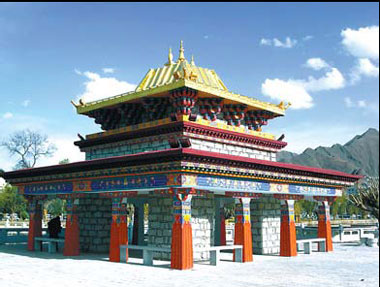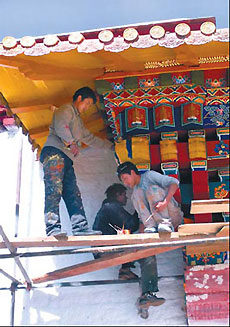Tibet transformed by govt funding
By Tan Hongkai (China Daily)
Updated: 2008-04-29 07:39
Updated: 2008-04-29 07:39
LHASA: In the warm spring sunshine, on a wooden folding ladder, a Tibetan artist is painting bright pink on the nose of a stone lion guarding the main entrance of Norbu Lingka, the previous summer residence of Dalai Lamas.
 A Tibetan-style pavillion on a square near the Norbu Lingka. [China Daily] |
On the scaffold at the entrance, six younger artists are putting new paint on the fainted color patterns on the wooden ornaments above the main gate.
They are running against time so the popular haunt for both Lhasa residents and tourists is ready to reopen on Thursday.
Not far to the southeast, on a new marble stool, sits 76-year-old Qiangba Gyatso. The Tibetan native of Ledu county, Qinghai province came in early March to visit his two children working in Lhasa.
"This was paved only a month ago," he pointed at the ground. "Lhasa keeps changing. Every time I come, it is different."
This is his third visit to Lhasa.
"Lhasa is getting prettier all the time. Look at the landscaping," he nodded at the sprawling new garden outside Norbu Lingka. In the distance, gardeners are watering new lawns in front of a newly built Tibetan-style pavilion, whose golden roof gleams against the azure sky.
 Workers paint the wooden ornaments above the main gat of Norbu Linka. [China Daily] |
Besides circumambulating local monasteries, Qiangba Gyatso enjoys basking in Lhasa's warm sunshine in the morning. Norbu Lingka is his new favorite.
"Although some shops had to give way to construction work," says Tsomo, a 34-year-old Lhasa resident. "It is good to see Norbu Lingka becoming more beautiful. We have a much better place to hang out."
Sources with the Tibet autonomous region's development and reform commission (DRC) said the renovation project costs 87 million yuan ($12.4 million). This is part of a latest renovation and preservation package for the region's major buildings of cultural significance, including the Potala Palace and Sakia monastery.
This is impressive for Tibet, where, in the words of Qiangba Puncog, chairman of the regional government, nine out of every 10 yuan spent by the local government are from transfer payment by the central government.
"Tibet would not have been what it is, were it not for the persistent favor from the State coffers and the variety of aid programs sponsored by fraternal provinces and municipalities," says Yangchen Dolkar, a deputy section chief with the regional DRC.
Tibet's per capita gross domestic product exceeded 12,000 yuan in 2007, almost doubling its 2002 figure, and the region's economy has, for seven consecutive years, maintained an annual growth of more than 12 percent.
That, according to Yangchen Dolkar, has much to do with outside assistance.
The four central government conferences on development issues in Tibet, in 1980, 1984, 1994 and 2001, have proved instrumental in materializing the dramatic changes in the region's economic landscape.
The 1994 meeting's idea to have other provinces, municipalities, central government offices, and major State-owned firms to team up with and assist localities in Tibet deserves particular credit for Tibet's current prosperity, says Zhang Jianjun, deputy chief of Tibet's office of one-on-one aid programs.
All the rest of the country has been involved in the high-profile aid-Tibet program.
|
||
|
||
|
|
|
|

